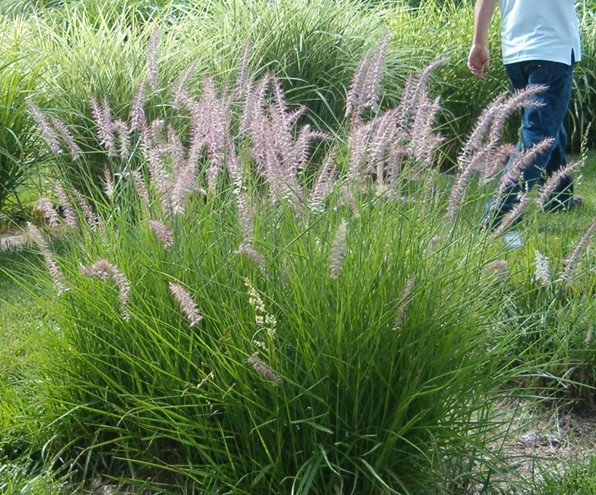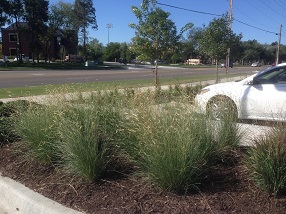Ornamental Grasses
Some hot trends in landscape design are using "native" plants, xeriscape plants, and natural gardening. The look of Kansas' famous Flint Hills, prairies filled with waving grasses mixed with wildflowers, fills this niche of native/xeriscape and the natural look. Landscape Architects world-wide are increasing the use of ornamental grasses and native plants into their designs. Many of these ornamental grasses are just improved varieties of our Kansas natives: Switchgrass, Little Bluestem, Big Bluestem, Blue Grama, and Sideoats Grama. Other grasses from other states and countries that have similar growing conditions are also being used.

'Karley Rose' Oriental Fountain Grass
On Our Grounds
We have a variety of ornamental grasses planted on our grounds. The perennials are mostly in the outer parts of the arboretum where they receive minimal or no water. There are also annual ornamental grasses planted in some of the flower beds near the building.
FAQS
How can I use ornamental grasses in my landscape?
When using ornamental grasses in landscape, consider using them as a replacement for shrubs. Plant in groupings. In small pocket gardens, you may use in groupings of 3-5 of the same cultivar. In large landscapes you can use in groups of 7-9 of some and perhaps hundreds in a group in borders. Consider planting them in natural flowing borders throughout the landscape, mixed in with clumps of wildflowers, perennials, or shrubs.
Ornamental grasses have beauty throughout the year, from lush green growth of spring and summer; fall colors of yellow/tan/rust; and the beautiful beige tones of winter. We try to wait until spring to cut them back for regrowth in order to take advantage of their winter textures and color. In the winter, dry ornamental grasses can be a fire hazard, so avoid planting large quantities next to buildings.

'Blonde Ambition' Blue Grama
What ornamental grasses will do well here?
Most ornamental grasses are warm season grasses - they green up in the spring after the last frost and go dormant with the first killing frost in the fall. Check the labels for hardiness and select plants that are hardy to 7A for Sedgwick County. Purple Fountain Grass Pennisetum 'Rubrum' is an example of a perennial hardy to zone 8, but not hardy to our zone 7A, so we treat it as an annual here.
- Ornamental Grasses publication
When should I cut back my ornamental grass?
The only maintenance really needed for ornamental grasses is cutting them back each spring. This is usually done up to the time when new growth is starting in early April. To receive the longest ornamental value out of the plant, then enjoy them all winter long, cut them back in mid-March. For the health of the plant, they can be cut back any time from fall to spring, but leave them until mid-March to get the most aesthetic value. Shear back close to the ground using either hand pruners, loppers or shearers. Power shearers make the pruning job go the fastest. Cut them as close to the ground as practical. Grasses may be divided in early spring at the time of greenup to plant in other areas of your landscape.

